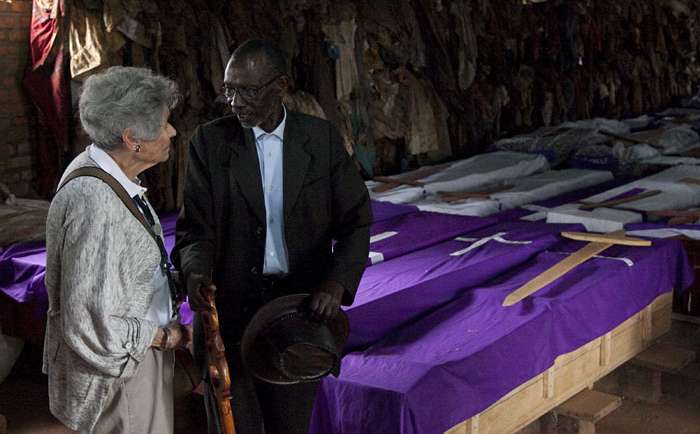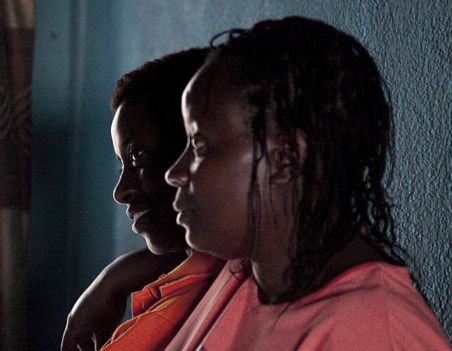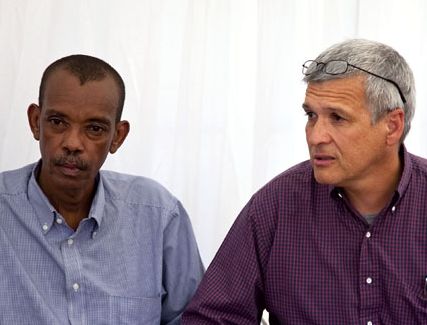April 06, 2014

By Mike Abramowitz, director of the Museum's Center for the Prevention of Genocide, who is in Kigali with a Museum delegation to participate in the 20th anniversary commemorations of the genocide in Rwanda.
Nearly 75 years ago, Margit Meissner fled Nazi-controlled France with her mother on her way to the United States, where she settled, married and eventually became a survivor volunteer at the United States Holocaust Memorial Museum. Last Tuesday, Margit toured the Ntarama Church with Jean-Baptiste Munyankor, a survivor of a 1994 massacre in which more than 5,000 people who had gathered for shelter inside this tiny Catholic church near Kigali were murdered.
Margit and Jean-Baptiste spent time surveying the destroyed church, where clothes of the victims still hang from the rafters, giant coffins containing multiple bodies of the victims lay on the floor, and the walls are still marked by the holes created by grenades lobbed in by militia.
As she has traveled around Rwanda this week, Margit says she has found many of the people she has met to be instinctively drawn to her because of what they see as a shared experience. “I as a survivor feel very much connected to the survivors I meet here because of their reactions to me,” said Margit.
Margit is part of a Museum delegation which has traveled to Rwanda this week to express solidarity with victims and survivors on a solemn occasion - the 20th anniversary of the genocide here, in which as many as one million Rwandans, predominantly Tutsis, were killed in a hundred days in 1994. The delegation is led by Museum Council chairman Tom Bernstein and Strive Masiyiwa, a member of the Museum’s Committee on Conscience which guides the work of the Center for the Prevention of Genocide. The delegation includes other Museum Council members, supporters and staff, and its visit will culminate on April 7 with the official national commemoration of the genocide in Kigali’s sports stadium, attended by UN Secretary-General Ban Ki-moon and other heads of state.
Over the past several days, the Museum delegation has met with survivors and eyewitnesses to the genocide, visited memorial sites like Ntarama and the Kigali Genocide Memorial, and heard testimony of truly heroic rescue and courage. We visited the home of Grace and Vanessa.

Grace, now 30, told us the story of how she was implored by a dying Tutsi woman to save her baby daughter. She named the baby Vanessa, carried her on her back to Eastern Congo, defying the wishes of her Hutu grandmother, and raised her as her own daughter and sister. Today Grace sells vegetables in a local market and Vanessa is a student at the Agahoza Shalom Youth Village, which was founded by the late Anne Heyman and patterned after a facility in Israel created for Holocaust survivors.
Our delegation, along with Carl Wilkens, the only American left in Rwanda during the genocide, visited the Gisimba orphanage in Kigali, the site of another amazing story of rescue by Damas Gisimba and his friend Carl. Together they told how they saved hundreds of orphans from murder by militia groups surrounding the orphanage during the genocide. In the audience were some of the children saved, some of whom had not seen Carl for two decades.

Both Carl and Damas spoke emotionally about their experience, remembering how Carl pleaded successfully with Jean Kambanda, the prime minister of the genocidal government, to call off a planned attack on the orphanage by the Interahamwe militia. “Courage isn’t the absence of fear,” Carl told the Museum group. “Courage is moving past fear.”
In addition to standing with the survivors of the genocide in Rwanda, Margit said she expects her experience this past week to inform her work as a volunteer guide at the Museum, where some of the themes of the genocide in Rwanda—such as neighbor turning on neighbor – track themes of the Holocaust that are addressed in the Museum’s Permanent Exhibition and special exhibition, “Some Were Neighbors: Collaboration and Complicity in the Holocaust.”
“This is a very important trip,” Margit said, “because it relates to the Museum’s larger goals, which are to remember the victims and learn the lessons of the Holocaust and to be aware of the responsibility of individuals not to stand by and watch. This is exactly in line with who we are.”
View All Blog Posts